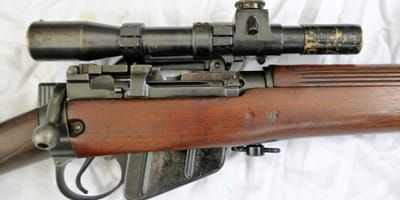THE .303 RIFLE No. 4 Mk. 1, Mk. 1*, Mk. 2 & No. 5 RIFLE

The No. 4
The No. 4 rifle introduced officially on the 15th of November 1939 and similar in appearance to the No. 1 Mk III SMLE series of rifles but easier to manufacture, requiring less time and less machining.
(note. No. 4`s are not SMLE`s as some refer to all Enfield’s as being)
They are visually different in having approximately 3 inches of exposed barrel (in order to accept the new 8-inch bladed spike bayonet) while an aperture sight to the rear of the action, gave a longer sight radius.
A heavier barrel and a strengthened action were designed to simplify production and produce better and more consistent accuracy.
To aid simplified production the old Enfield screw thread was abandoned and replaced with a standardised screw thread, which would greatly improve ease of supply for mass production.
This new No. 4 rifle can be found with a whole host of variations, introduced to speed up and simplify production. For example, the variation in barrel production with over 7 different types, some having varying numbers of groves e.g. 2, 4, 5 and 6 etc.
The No. 5
By 1943 it had become apparent that the equipment then being fielded for Jungle Warfare, was not totally satisfactory for the job in hand. And with War against Japan estimated to last at least several more years, some new equipment would be necessary.
One of these new pieces of equipment would be a No.4 lightened rifle, which would become the No.5 rifle, or as it is more commonly referred to; the Jungle Carbine.
Manufactured only from 1944 until 1947 (still in .303 calibre) it was a trimmed down No.4 with a shortened barrel with attached flash hider, and reduced fore-stock. The reduced barrel length led to the range on the rear sight only being graduated up to 800 yards, as opposed to the No. 4`s 1300, the butt was fitted with a rubber pad, metal was removed from certain areas, with other parts being produced in a modified and lightened form. It could also be fitted with the No. 5 bladed bayonet, attached to a lug under the flash hider.
It was officially introduced in September 1944 but many thousands had been produced before this date. It was declared obsolete in July 1947, but would carry on seeing service mainly in the far east in Malaya and Kenya in Africa into the late 50s to the early 60s.
At one point, it was being considered as a replacement to the No. 4. However, its downfall was its inability to stay sighted in, known as ‘wandering zero’, and many attempts were made in an effort to rectify this. It was finally decided it was an inherent design fault.
